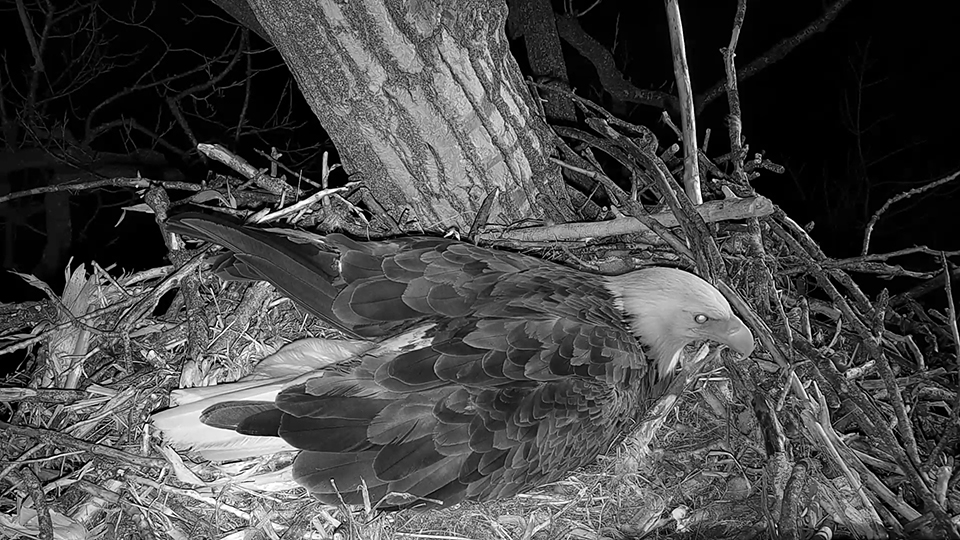On Tuesday March 14th, two brush pile burns were conducted south of the Decorah Eagles nest near the hatchery. During the early morning, the wind was blowing to the south, which carried smoke away from the nest. But at about 10:00 AM, the wind switched direction and began carrying smoke north toward the nest. Wind speed also increased from about 2.2 to about 9.2 miles per hour, which blew even more smoke and some light ash as the day progressed. At about 7:50 PM, HM left the nest. She stayed away until about 1:00, when she flew in and started incubation again. We believe that her eggs are still viable. Read through the blog or skip to the bottom for more information about her eggs.
Excessive blinking, unusual agitation

March 14, 2023: HM shortly before leaving the nest
A review of seven days of video footage between March 7 and March 14 shows that she is blinking her eyelids more often and seems more restless or agitated on the 14th than she was on previous nights. If you listen to the video, you’ll also hear something that startles her at about 7:20. We don’t know what it was, but while she looks around alertly, she doesn’t begin vocalizing, mantling, alarm calling, or doing anything else that we associate with intruders. When she flies out at 10:37 into the video (about 7:50 real-time), it is a panicked flight. Normally, the eagles carefully disengage with their eggs, holding their feet loosely as they step around and away from them before flying out. But HM left directly from the egg cup without moving away first. Her flight was very sudden and gave us no warning whatsoever.
In reviewing footage, area maps, and wind maps, we believe that the wind carried fire and light ash toward the nest. As the smoke increased, HM became increasingly alarmed and finally flew out. Eagles are very protective of their eggs and young, but they will abandon incubation and brooding if they perceive life-threatening danger. Intraspecific intrusion is one such case and fire is another. This also calls back into question whether or not eagles can smell. A 2017 study of captive raptors found that vultures and eagles can learn to associate a non-biologically relevant odor (peppermint, in this case) with food reward, which indicates that eagles can detect, categorize, and associate smells. Given what we saw, it seems highly likely that HM was reacting both to the irritant of the smoke (blinking) and the smell of the fire, which would have grown stronger throughout the day. At some point, her instincts told her to flee, and she did.
We’ve received assurances that no more burns will be held downwind or upwind of the nest during the eagles’ active season.
Will HM’s eggs hatch?
After seeing both eagles off the eggs, we investigated the events of the day and considered putting out the fire. But by that point, it had mostly burned itself out and smoke was no longer drifting through the air. Instead of adding to the disturbance with people and firetrucks, we decided to monitor the nest instead. HM and HD left their bluff perch around 9:30 and perched closer to the nest. We are lucky that Hatchery Mom came back to the nest to incubate after midnight.
We believe that HM’s eggs are still viable. Research on chicken eggs has found that they don’t start freezing until about 26F. The night of March 14 stayed above 26F (the lowest temperature was 27F at 8:30 and it warmed up to 30F after that), bald eagle eggs are larger than chicken eggs and so would take longer to lose heat, the eggs were uncovered for just five hours, and they were protected from wind and ambient temperature in the egg cup. HM and HD are back to their regular incubation schedule. We’ll see what happens.
 The Raptor Resource Project
The Raptor Resource Project The Raptor Resource Project
The Raptor Resource Project